
Urbana is a suburban census-designated place located in Frederick County, Maryland, United States. It lies at the I-270/MD 80 interchange, approximately 7.5 miles (12.1 km) south-east of Frederick and about 37 miles (60 km) north-west of Washington, D.C. Urbana started to develop circa 1999 and, as of the 2010 census, had a population of 9,175. It is part of the Washington metropolitan area.

Chestertown Historic District is a historic district in Chestertown, Maryland. It was listed on the National Register of Historic Places and designated a National Historic Landmark in 1970, and its area was increased in 1984. The town on the Chester River, became the chief port for tobacco and wheat on the Eastern Shore of Maryland between 1750 and 1790. The port declined thereafter, as Baltimore became the major port for such activity. In consequence, Chestertown acquired a collection of more than fifty Georgian style town houses. The 18th-century residential area survived without harm a 1910 fire that destroyed the central business district of Chestertown.

Gambrill House, also known as Boscobel House and Edgewood, is a house near Frederick, Maryland in the Monocacy National Battlefield. It was listed on the National Register of Historic Places in 1985.
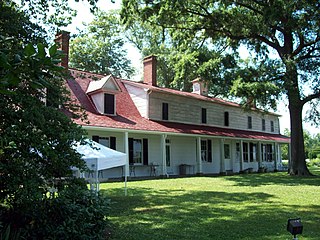
Sotterley Plantation is a historic landmark plantation house located at 44300 Sotterley Lane in Hollywood, St. Mary's County, Maryland, USA. It is a long 1+1⁄2-story, nine-bay frame building, covered with wide, beaded clapboard siding and wood shingle roof, overlooking the Patuxent River. Also on the property are a sawn-log slave quarters of c. 1830, an 18th-century brick warehouse, and an early-19th-century brick meat house. Farm buildings include an early-19th-century corn crib and an array of barns and work buildings from the early 20th century. Opened to the public in 1961, it was once the home of George Plater (1735–1792), the sixth Governor of Maryland, and Herbert L. Satterlee (1863–1947), a New York business lawyer and son-in-law of J.P. Morgan.
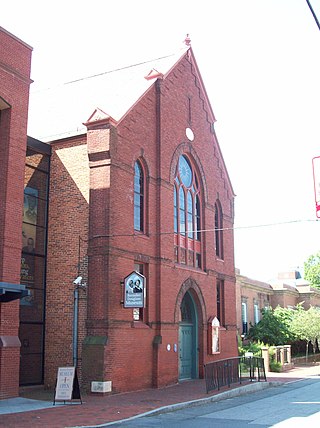
The Banneker-Douglass Museum, formerly known as Mt. Moriah African Methodist Episcopal Church, is a historic church at Annapolis, Anne Arundel County, Maryland. It was constructed in 1875 and remodeled in 1896. It is a 2+1⁄2-story, gable-front brick church executed in the Gothic Revival style. It served as the meeting hall for the First African Methodist Episcopal Church, originally formed in the 1790s, for nearly 100 years. It was leased to the Maryland Commission on African-American History and Culture, becoming the state's official museum for African-American history and culture. In 1984, a 2+1⁄2-story addition was added when the building opened as the Banneker-Douglass Museum.

The Poffenberger Road Bridge, near Jefferson, Maryland, is a wrought iron bridge by the Wrought Iron Bridge Company of Canton, Ohio. The bridge is similar to the Fourpoints Bridge elsewhere in Frederick County. The bridge is a single-span double-intersection Pratt truss. It was built circa 1878 and remains in daily use.

The John W. Coffren House and Store are two historic buildings located at Croom in Prince George's County, Maryland. This assemblage is significant for their architecture, as well as their association with the commercial history of the area and with John W. Coffren, local merchant and landowner. The Coffren House, built in 1861, has a Greek Revival entrance and interior detail. The Coffren Store, constructed ca. 1853, is a utilitarian structure, designed for use as a one-room general store. The store closed in 1945. The significance of the house and store together is that they are an intact example of house and store complexes that served rural communities in the county during the 19th century. Their builder, John W. Coffren (1828-1874), who rose from ditch digger to wealthy merchant, served on the Vestry of St. Thomas Church in Croom and on the Prince George's County School Board, as well as owning much of the property in the Village of Croom.

Grahame House, Graham House, Mansion House, Graeme House, or Patuxent Manor, is a historic home located at Lower Marlboro, Calvert County, Maryland. It is an 18th-century original 1+1⁄2-story brick shell laid in Flemish bond with a steeply pitched gable roof. Later alterations have included the purchase and removal of the fine paneling throughout the house to the Winterthur Museum, Garden, and Library.

Rose Hill Manor, now known as Rose Hill Manor Park & Children's Museum, is a historic home located at Frederick, Frederick County, Maryland. It is a 2+1⁄2-story brick house. A notable feature is the large two-story pedimented portico supported by fluted Doric columns on the first floor and Ionic columns on the balustraded second floor. It was the retirement home of Thomas Johnson (1732–1819), the first elected governor of the State of Maryland and Associate Justice of the United States Supreme Court. It was built in the mid-1790s by his daughter and son-in-law.

Fat Oxen is a historic home located near Urbana, Frederick County, Maryland, United States. It is a 1+1⁄2-story Flemish bond brick house over a high rough stone foundation, with a shorter kitchen wing. It was built about 1775 and is basically Georgian vernacular architecture in style. The home is a notable example of an English farmhouse in a region that was largely populated by German Americans.

Harris Farm is a historic home and farm complex located at Walkersville, Frederick County, Maryland, United States. The main house was built in 1855, and is a three-story center plan house in predominantly late Greek Revival syle, with some Italianate elements. The agricultural complex consists of a bank barn with an attached granary; a second frame barn that shares an animal yard with the bank barn; a row of frame outbuildings including a converted garage, a workshop, and a chicken house. There is also a drive-through double corn crib; and a frame pig pen from 1914. The 20th-century buildings consist of a frame poultry house, a dairy barn with milk house and two silos, and an octagonal chicken coop. A lime kiln is located on the edge of the property. The property is preserved as part of the Walkersville Heritage Farm Park.

Graceham Moravian Church and Parsonage is a historic church building and parsonage located at 8231 Rocky Ridge Road, MD 77 in Graceham, east of Thurmont, Frederick County, Maryland. It is a two-story Flemish bond brick church built in 1822, and covered with white stucco because of deteriorated masonry. The church was built as an addition to the adjacent meeting house and parsonage built in 1797. This building and the church's cemetery having uniform flat gravestones represents Maryland's only remaining 18th century Moravian settlement.

Lewis Mill Complex is a historic grist mill complex located at Jefferson, Frederick County, Maryland. The complex consists of seven standing structures, a house foundation, and the remains of an earlier millrace. It centers on an early 19th-century three-story brick mill structure with a gabled roof. The mill complex served German immigrant farmers in Middletown Valley between 1810 and the 1920s. It was rehabilitated in 1979-1980 for use as a pottery shop. Also in the complex are a stuccoed log house and log springhouse built about; a frame wagon shed and corn crib structure and frame barn dating from the late 19th century; and early 20th century cattle shelter and a frame garage.
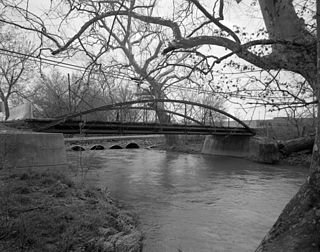
The Crum Road Bridge is a historic bridge near Frederick, Frederick County, Maryland, United States. It spanned Israel Creek southeast of Walkersville. The bridge is an iron bowstring pony bridge that is 62 feet (19 m) in length and 15.8 feet (4.8 m) in width. The Crum Road Bridge was built on or about 1875, and was probably constructed by the King Iron Bridge Company of Cleveland, Ohio.
The Wye Town Farm House is a historic home in Easton, Talbot County, Maryland, United States. It is of brick construction, one and one-half stories high and two rooms deep with a small one-story brick kitchen. A two-story addition was made in the 20th century. The original section of the house dates from about 1800.
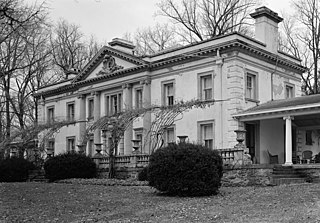
Liriodendron is a historic home and estate located at Bel Air, Harford County, Maryland, United States. It was the summer home of Laetitia and Dr Howard Kelly, a successful surgeon and founding member of the Johns Hopkins Medical College, and comprises the mansion named Liriodendron; the Graybeal-Kelly House; a c. 1835 bank barn; a c. 1898 carriage house; a c. 1850 board-and-batten cottage; and five other outbuildings including a corn crib, a smokehouse, two ice houses, and a shed. The 2+1⁄2-story, stuccoed brick mansion was designed by the Baltimore architectural firm of Wyatt and Nolting in the Georgian Revival style and constructed about 1898. The 2+1⁄2-story Georgian-style Graybeal-Kelly House, built about 1835, was the manor house for the farm until the mansion was constructed. It is used as a wedding, conference, and arts facility.

Readbourne is a historic home on the Chester River located at Centreville, Queen Anne's County, Maryland, United States. It is a five-part Georgian brick house: the center block was built in the early 1730s; the south wing in 1791; and the north wing in 1948. The central part of the house is the most significant, being a "T"-shaped, two-story brick building with a hip roof, measuring 60 feet (18 m) by 23 feet 6 inches (7.16 m). All of the brick walls are laid in Flemish bond.
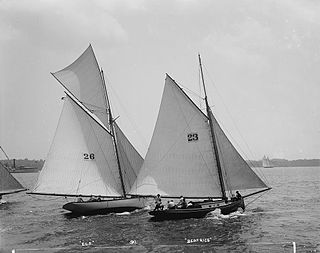
Elf is a racing yacht built in 1888 by George Lawley & Son of South Boston, Massachusetts, for William H. Wilkinson. She was designed by George F. Lawley and is the oldest small yacht in the United States. She is located at the Chesapeake Bay Maritime Museum in St. Michaels, MD.Talbot County, Maryland.
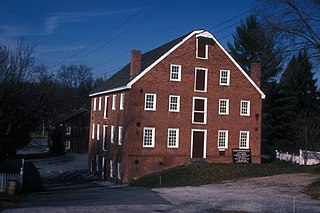
Union Mills Homestead Historic District is a national historic district at Westminster, Carroll County, Maryland, United States.

Oakdale is a historic plantation located in Daisy, (Woodbine) Howard County, Maryland, former home of Maryland Governor Edwin Warfield.























